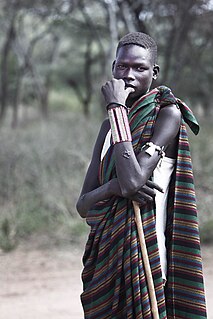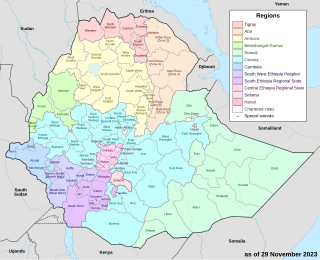
Southern Nations, Nationalities, and Peoples' Region is one of the nine ethnically based regional states (kililoch) of Ethiopia. It was formed from the merger of five kililoch, called Regions 7 to 11, following the regional council elections on 21 June 1992. Its capital is Awasa.

The Omo River in southern Ethiopia is the largest Ethiopian river outside the Nile Basin. Its course is entirely contained within the boundaries of Ethiopia, and it empties into Lake Turkana on the border with Kenya. The river is the principal stream of an endorheic drainage basin, the Turkana Basin.

The Mursi are a Nilotic pastoralist ethnic group in Ethiopia. They principally reside in the Debub Omo Zone of the Southern Nations, Nationalities, and People's Region, close to the border with South Sudan. According to the 2007 national census, there are 11,500 Mursi, 848 of whom live in urban areas; of the total number, 92.25% live in the Southern Nations, Nationalities, and People's Region (SNNPR).
Turkana is the language of the Turkana people of Kenya. It is spoken in northwestern Kenya, primarily in Turkana County, which lies west of Lake Turkana. It is one of the Eastern Nilotic languages, and is closely related to Karamojong, Jie and Teso of Uganda, to Toposa spoken in the extreme southeast of South Sudan, and to Nyangatom in the South Sudan/Ethiopia Omo valley borderland; these languages together form the cluster of Teso–Turkana languages.

The culture of Ethiopia is diverse and generally structured along ethnolinguistic lines. The country's Afro-Asiatic-speaking majority adhere to an amalgamation of traditions that were developed independently and through interaction with neighbouring and far away civilizations, including other parts of Northeast Africa, the Arabian Peninsula, India, Italy and Malaysia. By contrast, the nation's Nilotic communities and other ethnolinguistic minorities tend to practice customs more closely linked with South Sudan and/or the African Great Lakes region.

Omo National Park is one of the national parks of Ethiopia. Located in the Southern Nations, Nationalities, and Peoples' Region on the west bank of the Omo River, the park covers approximately 4,068 square kilometers, about 870 kilometers southwest of Addis Ababa; across the Omo is the Mago National Park. Although an airstrip was recently built near the park headquarters on the Mui River, this park is not easily reachable; the Lonely Planet guide Ethiopia and Eritrea describes Omo National Park as "Ethiopia's most remote park."
The languages of Ethiopia refers to the various spoken forms of communication in Ethiopia. It includes the nation's official languages, its national and regional languages, as well as its minority and foreign languages.

The Ilemi Triangle is an area of disputed land in East Africa. Arbitrarily defined, it measures between 10,320 and 14,000 square kilometres. Named after Anuak chief Ilemi Akwon, the territory is claimed by South Sudan and Kenya, and borders Ethiopia. Despite use and raids by tribes within Ethiopia, the Ethiopian government has never made an official claim on any of the Ilemi, and in fact agreed that the land was all Sudanese in the 1902, 1907, and 1972 treaties.

The Toposa are an ethnic group in South Sudan, living in the Greater Kapoeta region of the erstwhile Eastern Equatoria state. They have traditionally lived by herding cattle, sheep and goats, and in the past were involved in the ivory trade. They have a tradition of constant low-level warfare, usually cattle raids, against their neighbors.

Debub Omo is a Zone in the Ethiopian Southern Nations, Nationalities and Peoples' Region (SNNPR). Debub Omo is bordered on the south by Kenya, on the southwest by the Ilemi Triangle, on the west by Bench Maji, on the northwest by Keffa, on the north by Konta, Gamo Gofa and Basketo, on the northeast by Dirashe and Konso, and on the east by the Oromia Region. The administrative center of Debub Omo is Jinka.

The Nyangatom also known as Donyiro and pejoratively as Bumé are Nilotic agro-pastoralists inhabiting the border of southwestern Ethiopia and southeastern South Sudan and in the Ilemi Triangle with populations residing in both countries. They speak the Nyangatom language.
Kuraz is one of the woredas in the Southern Nations, Nationalities, and Peoples' Region of Ethiopia. It is the homeland of Daasanach people. Part of the Debub Omo Zone, Kuraz is bordered on the south by Kenya, on the west by the Ilemi Triangle, on the north by Nyangatom, and on the east by Hamer. The Omo River is flowing through Kuraz to Lake Turkana at the border of Kenya. The administrative center of this woreda is Omorate. Nyangatom woreda was separated from Kuraz.
Hamer is one of the woredas in the Southern Nations, Nationalities, and Peoples' Region of Ethiopia. It is named after Hamer people who live in this woreda. Part of the Debub Omo Zone, Hamer is bordered to the south by Kenya, to the southwest by Kuraz, to the west by Nyangatom, to the north by Bena Tsemay, and to the east by the Oromia Region; the Weito River separates it from the Oromia Region. Hamer includes part of Lake Chew Bahir along its southeastern border. The administrative center is Dimeka; other towns in include Turmi. Hamer was part of former Hamer Bena woreda.
The Teso–Turkana languages are a cluster of Eastern Nilotic languages, eastern South Sudan, northeastern Uganda, northwestern Kenya, and southwestern Ethiopia. In effect they form a dialect cluster consisting of c.2 million people.

Sport in Ethiopië include many fields, although Ethiopia is best known internationally for its middle-distance and long-distance runners. Seifu Mekonnen was an Olympic contestant for Ethiopia in boxing. The Ethiopian national football team won the 1962 African Cup of Nations. There are also traditional sports events, such as stick fighting which is popular amongst the Surma and Nyangatom people.
Nyangatom is a Nilo-Saharan language spoken in Ethiopia by the Nyangatom people. It is an oral language only, having no working orthography at present. Related languages include Toposa and Turkana, both of which have a level of mutual intelligibility; Blench (2012) counts it as a dialect of Turkana.
Toposa is a Nilo-Saharan language spoken in South Sudan by the Toposa people. Mutually intelligible language varieties include Jiye of South Sudan, Nyangatom of Ethiopia, Karimojong, Jie and Dodos of Uganda and Turkana of Kenya. Teso is lexically more distant.

Suri' is a three subgroups name for chai, tirmaga and baale people living in southwestern Ethiopia. Suri is composed of three subgroups; Chai, Timaga and Baale groups (self-names), politically and territorially different, but all speaking 'South East Surmic' languages within the Nilo-Saharan family, in the Surmic language group, which includes Mursi, Majang, and Me'en languages.

Kapoeta East County is an administrative region of Namorunyang State. Before reorganisation of states in 2015, it was a part of Eastern Equatoria state in South Sudan, bordered by Kenya to the south, Ethiopia to the east and Jonglei state to the west. It is part of the Greater Kapoeta region of the state. The largest ethnic group is the Toposa people. The principal town is Narus. The county includes the disputed Ilemi triangle, controlled by Kenya. The emblem of the county is a horned bull, with big humps and a large tail.
Nyangatom is one of the woredas in the Southern Nations, Nationalities, and Peoples' Region of Ethiopia. It is named after Nyangatom people who live at this woreda. Part of the Debub Omo Zone, Nyangatom is bordered on the south by Kuraz, on the west by the Ilemi Triangle, on the northwest by the Bench Maji Zone, on the north by Selamago, and on the east by Hamer. The Omo River is flowing along the northern and western border of Nyangatom. Nyangatom was separated from Kuraz woreda.











